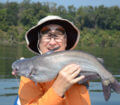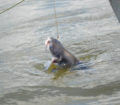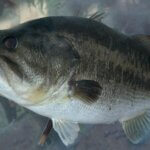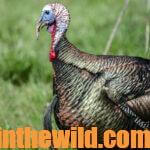To learn more about fishing for catfish, go to http://amzn.to/W900eu. For free copies of “The Catfish Catcher’s Cookbook,” visit https://johninthewild.com/free-books.
“I catch catfish all summer long in 2-5 foot deep water,” Robert Outlaw of Brundidge, Alabama, told me. Well, when I heard those words, I knew I’d catfished in the summertime all my life and never caught a catfish in 2 feet of water when the air temperature was 90-115 degrees. Like most catfishermen in the hot summer, I assumed that the catfish would be in one of two places: below the dams where hydroelectric power was being generated, and the water was the coolest since it came from the bottom of the lake above the dam; or in deep water, feeding along a thermocline. So, when I asked Outlaw why the catfish would be in 2-foot deep water during the hottest time of the year, he simply said, “They feed there.”
 I thought perhaps the bait fish would be schooling in that shallow water, and the catfish would be feeding on the bait fish. But Outlaw went on to explain that, “I’m fishing shallow-water sandbars. The catfish come up on those sandbars to feed on mussels at night. The bigger mussels in most lakes often will die off as the weather turns hot, and then the catfish feed on these dead mussels. But also when I’ve been cleaning summertime catfish, I’ve found small mussels inside the stomachs of those catfish. Although the catfish feed primarily at night, I also can catch them early in the morning and late in the evening on a rod and reel, fishing with dip baits.”
I thought perhaps the bait fish would be schooling in that shallow water, and the catfish would be feeding on the bait fish. But Outlaw went on to explain that, “I’m fishing shallow-water sandbars. The catfish come up on those sandbars to feed on mussels at night. The bigger mussels in most lakes often will die off as the weather turns hot, and then the catfish feed on these dead mussels. But also when I’ve been cleaning summertime catfish, I’ve found small mussels inside the stomachs of those catfish. Although the catfish feed primarily at night, I also can catch them early in the morning and late in the evening on a rod and reel, fishing with dip baits.”
A dip bait is a rubber, sponge-like material with treble hooks on the bottom that holds the dip bait and allows the scent from the dip bait to slowly dissolve in the water and provides a trail that the catfish can follow to eat the bait. However, most of Outlaw’s catfish are caught on jumpbox trotlines in the summer. Jumpboxes are trotlines already rigged that lay inside a square box with hooks with bait on them that are wedged between rubber gaskets. A jumpbox fisherman throws an anchor and a float out the back of his boat and runs his motor as the trotline hooks jump out of the box and go to the bottom. The advantage to using a jumpbox is the baited hooks can be put out very quickly in any segment of water.
 There are several reasons that Outlaw prefers using jumpbox trotlines. Outlaw can:
There are several reasons that Outlaw prefers using jumpbox trotlines. Outlaw can:
* put out the lines anywhere he wishes in the lake and doesn’t have to attach them to the bank or any structure in the lake;
* bait the hooks on the lines on the trotlines in the jumpboxes in about 45 minutes and coil the lines, so that the hooks, the weights and the floats can be pulled out of the jumpbox as he backs up his pontoon boat;
* use the jumpboxes to put out a 50-hook trotline in about 10 minutes;
* run the lines easily, catch the catfish and rebait the lines again for the next night of fishing; and
* produce 20-30 catfish per night on either a 50-hook trotline or a 100-foot trotline.
Berkley Gulp! offers numerous options for taking catfish, if you don’t have access to dead bait for your rod or jug fishing, including: Catfish Chunks; Catfish Dough; Catfish Dip Worms; PowerBait’s Catfish Power Dip, Catfish Bait Chunks and Catfish PowerPunch. www.berkley-fishing.com
 Editor’s Note: Be sure to check regulations in your state on trotlining before using trotlines or jumpboxes.
Editor’s Note: Be sure to check regulations in your state on trotlining before using trotlines or jumpboxes.
While in Eufaula, I always stay at Lakepoint Resort in the Alabama State Park (http://www.alapark.com/lakepoint-state-park), where the rooms have views of the lake, and the food is delicious. Contact the sales director, Sone Kornegay, at 334-687-8011 to learn more. Email pam@alabamablackbeltadventures.org to learn more about Alabama Black Belt Adventures which cover fishing at Lake Eufaula.










